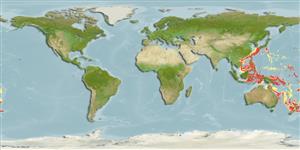Haliporoides sibogae (De Man, 1907)
Jack-knife shrimp| Native range | All suitable habitat | Point map | Year 2050 |

|
| This map was computer-generated and has not yet been reviewed. |
| Haliporoides sibogae AquaMaps Data sources: GBIF OBIS |
Classification / Names आम नाम | उपशब्द | CoL | ITIS | WoRMS
Malacostraca | Decapoda | Solenoceridae
Environment: milieu / climate zone / गहराई सीमा / distribution range पारिस्थितिकी
; गहराई सीमा 100 - 1463 m (संदर्भ 409), usually 300 - 600 m (संदर्भ 409). Tropical, preferred 26°C (संदर्भ 107945); 33°N - 44°S, 103°E - 176°W
Distribution देश | ऐफ ऐ ओ क्षेत्र | Ecosystems | संयोग | भूमिका
Indo-West Pacific: Madagascar to Japan and New Zealand (Ref. 8). Pérez Farfante recognizes 3 subspecies: Haliporoides sibogae australiensis from Australia; Haliporoides sibogae madagascariensis from Madagascar and Reunion; and Haliporoides sibogae sibogae from Malaysia to Japan and New Zealand (Ref. 75620).
Length at first maturity / आकार / Weight / Age
परिपक्व अवधि: Lm ?, range 10 - ? cm Max length : 16.5 cm BL पुल्लिंग / अलिंग; (संदर्भ 8); 20 cm BL (female)
Life cycle and mating behavior परिपक्व अवधि | पुनरुत्पत्ति | मछलीऔ का अंडे देना | Eggs | Fecundity | Larvae
Main reference
संदर्भ | संयोजक | सहयोगीयो
Holthuis, L.B. 1980 FAO Species Catalogue. Vol. 1. Shrimps and prawns of the world. An annotated catalogue of species of interest to fisheries. FAO Fish. Synop. 125(1):271 p. Rome: FAO. (संदर्भ 8)
IUCN Red List Status
(संदर्भ 130435: Version 2025-1)
CITES status (संदर्भ 108899)
CMS (संदर्भ 116361)
Threat to humans
Human uses
मात्स्यिकी: व्यापारिक
FAO - मात्स्यिकी: landings | FishSource | Sea Around Us
साधन
अधिक जानकारी
इंटरनेट स्रोत
BHL | BOLD Systems | CISTI | DiscoverLife | FAO(मात्स्यिकी: ; publication : search) | Fishipedia | GenBank (genome, nucleotide) | GloBI | Gomexsi | Google Books | Google Scholar | Google | PubMed | Tree of Life | Wikipedia (Go, खोज) | Zoological Record



